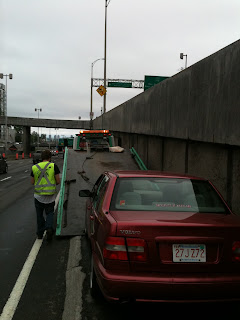A few observations post-operation.
1) The "check engine" light has been on almost the entire time after the repair (I honestly can't remember when it first turned on, but it was within the first couple hundred miles). I suspected that the oxygen sensors were put in backwards, but that is not the case. I have noticed appreciable lag in the engine response, especially in situations like a 4th gear pull when trying to change lanes on the highway (i.e. low torque scenario). This is an entirely haptic observation but I've been driving this car long enough to notice these things. Most likely, the oxygen sensors needed replacing and/or were damaged in the installation process and are now mucking up the ECU reading; which would throw off the fuel injection mapping.
1) The "check engine" light has been on almost the entire time after the repair (I honestly can't remember when it first turned on, but it was within the first couple hundred miles). I suspected that the oxygen sensors were put in backwards, but that is not the case. I have noticed appreciable lag in the engine response, especially in situations like a 4th gear pull when trying to change lanes on the highway (i.e. low torque scenario). This is an entirely haptic observation but I've been driving this car long enough to notice these things. Most likely, the oxygen sensors needed replacing and/or were damaged in the installation process and are now mucking up the ECU reading; which would throw off the fuel injection mapping.
2) In the last few hundred miles, the exhaust has gotten significantly louder, lower pitched, and sketchy-sounding in general. I think the clamp between the cat pipe and muffler pipe has been working itself loose over time. I bought some cherry loctite for the clamp hardware so that should be an easy fix.
3) Most concerning of all, there is a clicking noise which is very clearly linked to engine RPM. While I was skeptical about there being an exhaust manifold leak, I think that a healthy dose of - not always smooth - highway driving has evinced the issue. This one will be harder to check, especially because I'd have to submit myself to carbon-monoxide poising to check it. Maybe I'll cave and let the shop diagnose this issue. This may also be contributing to observation 2.
After addressing 2, I'll probably take it to the shop to avoid the dangerous fumes. It would be fun to do all the OBD II diagnostic stuff with an oscilloscope, but I don't have access to one currently (grad school soon!). Definitely making a good case for that pocket scope I've been procrastinating buying for forever.
But it's not all bad! After all, the brick has traveled another 2000 miles in sweltering heat and not broken down once. In other news, I was able to sell the old catalytic converter to the gentlemen at Davis Converters for a profit of $101. They won't reimburse you for shipping, but they sent a check for $128 and it was $27 to ship so that opens up some room in the budget to address the above issues. Interestingly enough, on a recent 900 mile trip I also monitored the fuel economy in both directions and the results were fairly consistent with what I used to get: 28.7 mpg there, 27.9 mpg back, versus about ~ 29 mpg in the past. The A/C was on full blast the entire time too so I was pleasantly surprised :)
Score:
D.E.C. catalytic converter - $396.55 (FREE SHIPPING!)
+ Exhaust flange gasket - $3.95
+ Oxygen Sensor Socket - $17.00
- Catalytic Converter Sold - $101.00
= $315.50
($2000 - 315.50 = 1684.50)
Score:
D.E.C. catalytic converter - $396.55 (FREE SHIPPING!)
+ Exhaust flange gasket - $3.95
+ Oxygen Sensor Socket - $17.00
- Catalytic Converter Sold - $101.00
= $315.50
($2000 - 315.50 = 1684.50)

.JPG)
.JPG)
.JPG)
.JPG)
.JPG)
.JPG)
.JPG)
.JPG)
.JPG)
.JPG)
.JPG)

.JPG)
.JPG)
